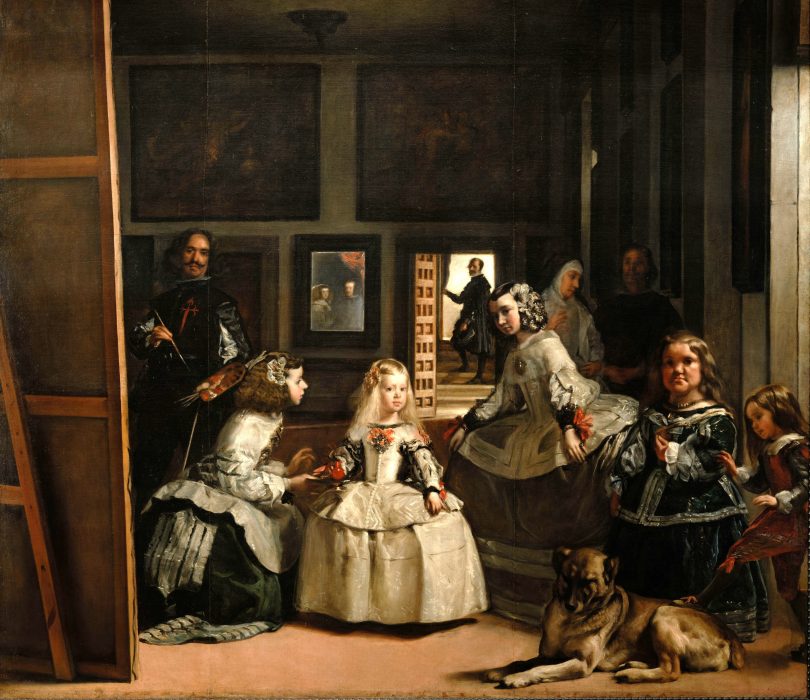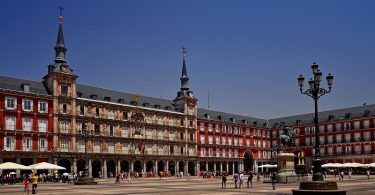Diego Velazquez (1599-1660) is the Spanish painter who painted probably Spain’s most famous painting called Las Meninas or in English known as The maids of Honour, which is a 17th-century royal family portrait that hangs in the Prado museum in Madrid. Velazquez, originally from Seville, is probably Spain’s most famous Spanish painter in history together with Francisco de Goya and El Greco. Diego Velazquez was known for his ambitious character and he always aspired his whole life to paint only for the best, which he in the end achieved when he got promoted as main court painter for King Philip IV and his family.
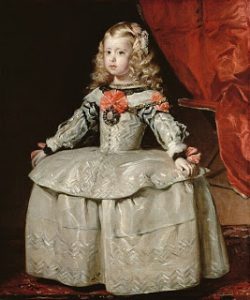 Las Meninas is a royal portrait painted by Velazquez of little princess Margaret Theresa of Spain when she is five years old and shows the little princess accompanied by her maids of honour or in Spanish know as Las Meninas. This little princess has been painted a lot by Velazquez as she was destined to marry her uncle of her mother’s side; Leopold I, Holy Roman and paintings of her were often sent to him to keep him informed on her appearances. Las Meninas is a special painting though as it is not a standard royal portrait of a princess but it contains all kinds of d
Las Meninas is a royal portrait painted by Velazquez of little princess Margaret Theresa of Spain when she is five years old and shows the little princess accompanied by her maids of honour or in Spanish know as Las Meninas. This little princess has been painted a lot by Velazquez as she was destined to marry her uncle of her mother’s side; Leopold I, Holy Roman and paintings of her were often sent to him to keep him informed on her appearances. Las Meninas is a special painting though as it is not a standard royal portrait of a princess but it contains all kinds of d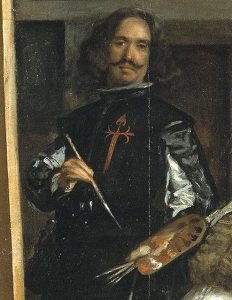 etails that were not very common for royal paintings done at that time.
etails that were not very common for royal paintings done at that time.
The first odd detail is that Velazquez has depicted himself as well on the portrait, you can see him while he is working on a painting on the left side of the work. On his outfit stands out the red cross which is a symbol for the order of Santiago, an aristocratic order at the time of which only noble and high estimated people could become a member off. Velazquez, who had always been very ambitious, finally became a member of this important order 5 years after he painted las Meninas and him, or someone else, probably has added the cross afterwards.
On Velazquez right side on the painting, we can see in the reflection of the mirror, behind the princess, a rather vague image of the king and queen, Philip IV and his wife Mariana de Austria. On the foreground of the painting we can see the princesses maids of honour, the aristocratic girls Isabel de Velasco and María Agustina Sarmiento de Sotomayor. On the right foreground, two servant dwarfs are shown, with the tallest one looking directly at the viewer. This female dwarf, known as María Bárbara Asquín was originally from Germany an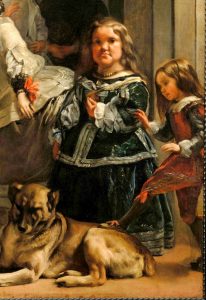 d was the princess main chambermaid and always accompanied her wherever she went with water, food and other necessities. The smaller, younger dwarf, who touches the dog with his foot, was a noble Italian servant called Nicolasito Pertusato, who became later the Kings main chamber servant.
d was the princess main chambermaid and always accompanied her wherever she went with water, food and other necessities. The smaller, younger dwarf, who touches the dog with his foot, was a noble Italian servant called Nicolasito Pertusato, who became later the Kings main chamber servant.
The woman with the nun outfit, behind the maids of honour was the princess´s main nanny, called Marcela de Ulloa. The outfit she was wearing was a widows robe as the was mourning for her late husband at the time. She is depicted while talking to Diego Ruíz Azcona who is referred to as a mentor or body guard but not much more is known about him. The man standing in the door opening is José Nieto Velázquez, the queen’s main chamberlain during the 1650s and back then head of the royal tapestry works, who also may have been a relative of Diego Velazquez himself. Nieto is shown on the painting pausing, with his right knee bent and both his feet on two different steps and it is uncertain whether he is coming or going in the scene.
The posture of Nieto, and of the rest of the characters in the painting have always led to various theories concerning the story behind the scene. The main thought is that Velazquez tried to depict an instant flash of his royal painting studio he had at the royal palace back then while he is working on a painting of the King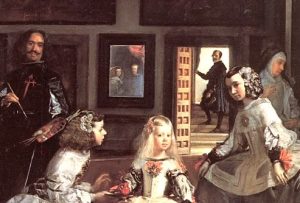 and the Queen. The image could be a reflection of the little princess that comes into Diego´s studio to have a look while he is working, accompanied by her maids of honour.
and the Queen. The image could be a reflection of the little princess that comes into Diego´s studio to have a look while he is working, accompanied by her maids of honour.
Another theory is that it is a reflection of the painter working in his studio on just a painting while the little princess is playing with her chambermaids in his studio and then the King and Queen walk into his working studio as well which is shown on the reflection in the mirror. Therefore the two chambermaids also start making a reverence as they do this towards the royal couple that has just walked in.
It was known that Velazquez had a very close relationship with the royal family who he served for over more than 33 years, especially the King was devastated when Velazquez died in 1660 at the age of 61. The painting was meant to hang in one of the Kings main working rooms at the time and therefore probably the most important characters in the Kings life are depicted in the painting, perhaps trying to capture a moment in everyone´s life at the time. The fact is that Las Meninas is still after all these years an intriguing painting that creates an uncertain relationship between the viewer and the figures shown in the painting, especially some of the main figures look directly at the viewer which creates doubt on what is really going one on the scene. The painting is definitely worth checking out for real though and if you have the chance you should try to have a look at it yourself next time you are in the Prado museum.



